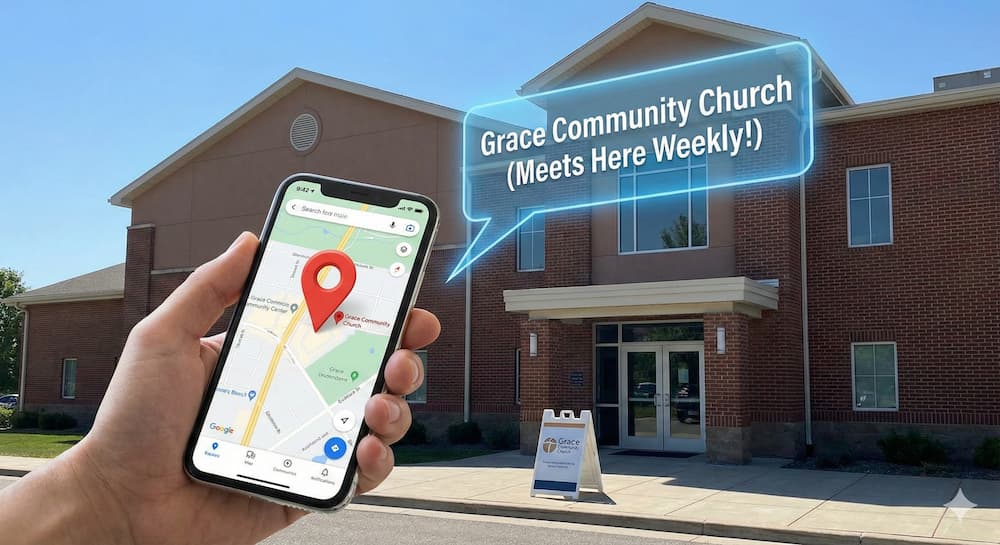The Ultimate Church Planner: Eternal Principles for Kingdom Efficiency
Church planning can get really confusing (and weighed down by subscription services). Use this simple 8-step strategy to get your entire team on the same page. Every day.

The church planner is difficult to master.
Everyone has a different productivity system.
Every staff member has a different scheduling philosophy.
Every team member has different “optimal workflow” conditions.
It matters not.
There are key principles that can guide the creation and implementation of your church planner so that everybody can get on the same page without forcing everybody to yield to a single management or productivity style.
If you implement these principles in your church planner strategy, you will succeed in streamlining a workflow for the entire church.
Let’s not wait any longer.
Here are 8 principles to streamline your church planning strategy that will both help you to create a uniform workflow experience for your church staff and volunteer and help guide you to make the right church planning software decision.
1. Focus on creating consistency and reliability, not complex features
It’s easy to get distracted, when creating a system, by the potential to capture every complex possibility that could come your way as a church.
The result of front-loading this concern is that you create a planning system that is far too big, convoluted, and bloated with “what if” contingency plans that learning the system becomes a task that is itself too big to plan or schedule.
Your church planner should be a tool that can be introduced and taught to your team in a single meeting.
If you have a larger church that requires more complex features, this meeting could be a 3 hour lunch meeting that breaks down into smaller teams so that team leads can instruct their teams on features and how their team will be utilizing the tool.
Nevertheless—the important aspects of a church planner should boil down to 3-4 core tasks that it can perform that staff and volunteers can utilize to manage and schedule events, administer meetings, and track progress on key internal and team-relevant projects.
Anything more is like placing too many birthday candles on the cake—at some point, putting the candles “5” and “0” works better than putting 50 individual candles on the small circular surface.
So too with church planning features.
In the philosophy of Steve Jobs, a tool should be measured by how much we don’t think about it, not how cool and distracting its features are.
Your tool should fit in your church hand-in-glove.
As you implement a church planning strategy or software, keep that in mind—the cash value of the software should be significant for the fluid and flexible functionality of your church.
2. Reduce your intake points as much as possible
This is controversial, but should be a core value of your church planning strategy:
Reduce your intake points to as close to 1 as possible.
What does this mean?
An intake point is a place where you store queued tasks, information, and requests.
Think about how many intake points you currently have.
Where do you have books and papers lying around?
Where do you have thousands of unread email messages?
Text messages?
Social media messages?
Sticky notes?
A secretary?
A to-do list?
Every single “intake point” is a vacuum for clutter and forgotten tasks.
Reduce all of these points to a single processing point, if possible, and dedicate a certain amount of time each day to processing all of the accumulated queries into a single batch and process them in a single sitting.
It’s not always possible to reduce all intake points to one point and all batch processing sessions to one session. Sometimes the best you can manage is two—text message and email; or email and secretary. Whatever your system, put pressure on it to be as small as possible so that it can handle as much as possible.
The more intake points you have, the more overwhelming the chaos of your church will feel to each person.
Intake point minimalism should be a core value of your church’s task management philosophy.
3. Outsource calendar management to a separate staff
There should be a point person for calendar management.
This person should be administratively gifted and detail oriented.
This calendar point person is in charge of resolving technical issues surrounding the calendar and administering calendar support for team leads.
The calendar point person should not be the gatekeeper for every scheduling request. Whatever software you use should have the capacity to give scheduling power to team leads. But this person should be able to resolve critical problems that arise, including scheduling conflicts, IT errors, schedule sharing, and scheduling request notifications.
It is crucial to have this person so that church staff can focus on using the tool, not troubleshooting it. This also makes it possible for church staff to have a positive experience of your church planning strategy, and aggregates all negative experience into a single user experience—that is, the point person for the church calendar.
4. Invest in a worthwhile planning software
The planning software you use shouldn’t be free.
The money you save using a free scheduling or planning software will be spent ten times over in energy and frustration on the other end.
You should use a church planning software that is dynamic and powerful enough to process all your time management and task management requests.
Furthermore, your should use a planning software with a devoted customer service team that is able to help your point person easily and quickly troubleshoot any user errors that arise as you populate the service with your church’s schedule.
Finally, you should choose a church planning software that easily integrates with other digital features in your church—or, which ideally offers and supports those other features.
For example, if your church has a digital automated recurring giving feature to make tithing automatic through an app, your church planning software should synchronize and play well with the software you use for that. Again, ideally, the software you use for church planning will have a recurring giving feature built into the service so that you can manage your church’s financials and calendar from the same backend interface.
5. Take all variables into account—domains, projects, and people
When architecting the population of your church’s calendar, it’s important to categorize each domain of interest, major and minor project, and people group into the most effective grouping.
For example, when setting domains, you don’t want to break up preaching, worship, and volunteers into entirely separate domains—these are integrally related. Instead, your categorization should look more like this—Sunday Service, Accounting, Volunteer Management, etc.
Each of these domains carries various projects. For example, the Sunday Service domain houses preaching, worship, and volunteer projects. Even though the Volunteer Management domain will house projects that lend administrative support to the Sunday Service domain, it makes intuitive sense that the two domains be administered separately, whereas projects such as “Preaching” and “Worship” should be coordinated because they are so closely related, being features of a singular event on the church schedule.
6. Use your planner to ensure staff are putting the right hours into the right places
When you track who is where — and when they are there — your church schedule functions simultaneously as a logistical scaffolding for your church’s task management as well as an informal timecard for critical staff (and volunteers).
Through the regular review of these hours, you can easily identify if a staff or volunteer is putting too much time (or too little time) in the right places (or the wrong places).
Use this schedule as a litmus test for if your church’s delegated staffing budget is yielding the projected ROI in man hours devoted to particular projects, or whether those team members’ hours are being inappropriately routed to projects that distract from the purpose of their designated and budgeted salaries.
For example, if your youth pastor keeps getting roped in to provide prep for Sunday School, and is spending inadequate hours on preparing the youth ministry, then this is a red flag that the church can easily identify and fix based on a simple analysis of the scheduling data.
A good scheduling software will allow you to narrow in on one person and see exactly how they are spending their time so that you can complete tasks like this to make your church more efficient and effective.
7. Have a monthly meeting devoted strictly to scheduling
Part of keeping a tool efficient is performing regular maintenance.
A schedule is one of the easiest things in the world for half your department to use, and the other half to ignore.
This is why it is crucial for you to use the planning software exclusively in the church so that half the church isn’t using Google Calendar and the other half the planning software.
Your church planner should be uniformly used so that it is a reliable tool.
One of the ways to ensure this is to have a monthly calendar review which performs a deep-dive into the church’s calendar, using the church planner software your church has designated.
This will prompt church staff and volunteers to regularly use the tool to manage their church schedule, and therefore make the schedule a reliable source of information for the rest of the church.
8. Create and administer tiers of schedule access
A worthwhile church planner service will offer tiers of scheduling access.
This means that your church will have tiers of leadership, staff, and volunteers with varying access to scheduling data and features.
You don’t want every volunteer to be able to see the pastor’s personal schedule, including his counseling meetings.
Certain kinds of meetings should only be accessible by the secretary and those in the meeting.
Others are leadership-wide accessibility.
And other events will have team-specific accessibility.
Clearly delineating these tiers and groups, and choosing a church planning software that adequately equips you to deploy these tiers of scheduled events and invitations, is very important to the usefulness of your church planner strategy and tool.
Over to you
Read over these principles with your leadership team this week.
Review the best church planning software options.
Choose the option which best enables you to manifest these principles so that your church can fill up the schedule with valuable, kingdom work.
Following these principles will enable you to more effectively follow Jesus’s call to the church to reach the world with his kingdom.
Church planning is not insignificant to the kingdom.
Be diligent in strategizing and choosing your church planning tool.
This, too, is kingdom work.
Sign Up for Product Updates
The church planner is difficult to master.
Everyone has a different productivity system.
Every staff member has a different scheduling philosophy.
Every team member has different “optimal workflow” conditions.
It matters not.
There are key principles that can guide the creation and implementation of your church planner so that everybody can get on the same page without forcing everybody to yield to a single management or productivity style.
If you implement these principles in your church planner strategy, you will succeed in streamlining a workflow for the entire church.
Let’s not wait any longer.
Here are 8 principles to streamline your church planning strategy that will both help you to create a uniform workflow experience for your church staff and volunteer and help guide you to make the right church planning software decision.
1. Focus on creating consistency and reliability, not complex features
It’s easy to get distracted, when creating a system, by the potential to capture every complex possibility that could come your way as a church.
The result of front-loading this concern is that you create a planning system that is far too big, convoluted, and bloated with “what if” contingency plans that learning the system becomes a task that is itself too big to plan or schedule.
Your church planner should be a tool that can be introduced and taught to your team in a single meeting.
If you have a larger church that requires more complex features, this meeting could be a 3 hour lunch meeting that breaks down into smaller teams so that team leads can instruct their teams on features and how their team will be utilizing the tool.
Nevertheless—the important aspects of a church planner should boil down to 3-4 core tasks that it can perform that staff and volunteers can utilize to manage and schedule events, administer meetings, and track progress on key internal and team-relevant projects.
Anything more is like placing too many birthday candles on the cake—at some point, putting the candles “5” and “0” works better than putting 50 individual candles on the small circular surface.
So too with church planning features.
In the philosophy of Steve Jobs, a tool should be measured by how much we don’t think about it, not how cool and distracting its features are.
Your tool should fit in your church hand-in-glove.
As you implement a church planning strategy or software, keep that in mind—the cash value of the software should be significant for the fluid and flexible functionality of your church.
2. Reduce your intake points as much as possible
This is controversial, but should be a core value of your church planning strategy:
Reduce your intake points to as close to 1 as possible.
What does this mean?
An intake point is a place where you store queued tasks, information, and requests.
Think about how many intake points you currently have.
Where do you have books and papers lying around?
Where do you have thousands of unread email messages?
Text messages?
Social media messages?
Sticky notes?
A secretary?
A to-do list?
Every single “intake point” is a vacuum for clutter and forgotten tasks.
Reduce all of these points to a single processing point, if possible, and dedicate a certain amount of time each day to processing all of the accumulated queries into a single batch and process them in a single sitting.
It’s not always possible to reduce all intake points to one point and all batch processing sessions to one session. Sometimes the best you can manage is two—text message and email; or email and secretary. Whatever your system, put pressure on it to be as small as possible so that it can handle as much as possible.
The more intake points you have, the more overwhelming the chaos of your church will feel to each person.
Intake point minimalism should be a core value of your church’s task management philosophy.
3. Outsource calendar management to a separate staff
There should be a point person for calendar management.
This person should be administratively gifted and detail oriented.
This calendar point person is in charge of resolving technical issues surrounding the calendar and administering calendar support for team leads.
The calendar point person should not be the gatekeeper for every scheduling request. Whatever software you use should have the capacity to give scheduling power to team leads. But this person should be able to resolve critical problems that arise, including scheduling conflicts, IT errors, schedule sharing, and scheduling request notifications.
It is crucial to have this person so that church staff can focus on using the tool, not troubleshooting it. This also makes it possible for church staff to have a positive experience of your church planning strategy, and aggregates all negative experience into a single user experience—that is, the point person for the church calendar.
4. Invest in a worthwhile planning software
The planning software you use shouldn’t be free.
The money you save using a free scheduling or planning software will be spent ten times over in energy and frustration on the other end.
You should use a church planning software that is dynamic and powerful enough to process all your time management and task management requests.
Furthermore, your should use a planning software with a devoted customer service team that is able to help your point person easily and quickly troubleshoot any user errors that arise as you populate the service with your church’s schedule.
Finally, you should choose a church planning software that easily integrates with other digital features in your church—or, which ideally offers and supports those other features.
For example, if your church has a digital automated recurring giving feature to make tithing automatic through an app, your church planning software should synchronize and play well with the software you use for that. Again, ideally, the software you use for church planning will have a recurring giving feature built into the service so that you can manage your church’s financials and calendar from the same backend interface.
5. Take all variables into account—domains, projects, and people
When architecting the population of your church’s calendar, it’s important to categorize each domain of interest, major and minor project, and people group into the most effective grouping.
For example, when setting domains, you don’t want to break up preaching, worship, and volunteers into entirely separate domains—these are integrally related. Instead, your categorization should look more like this—Sunday Service, Accounting, Volunteer Management, etc.
Each of these domains carries various projects. For example, the Sunday Service domain houses preaching, worship, and volunteer projects. Even though the Volunteer Management domain will house projects that lend administrative support to the Sunday Service domain, it makes intuitive sense that the two domains be administered separately, whereas projects such as “Preaching” and “Worship” should be coordinated because they are so closely related, being features of a singular event on the church schedule.
6. Use your planner to ensure staff are putting the right hours into the right places
When you track who is where — and when they are there — your church schedule functions simultaneously as a logistical scaffolding for your church’s task management as well as an informal timecard for critical staff (and volunteers).
Through the regular review of these hours, you can easily identify if a staff or volunteer is putting too much time (or too little time) in the right places (or the wrong places).
Use this schedule as a litmus test for if your church’s delegated staffing budget is yielding the projected ROI in man hours devoted to particular projects, or whether those team members’ hours are being inappropriately routed to projects that distract from the purpose of their designated and budgeted salaries.
For example, if your youth pastor keeps getting roped in to provide prep for Sunday School, and is spending inadequate hours on preparing the youth ministry, then this is a red flag that the church can easily identify and fix based on a simple analysis of the scheduling data.
A good scheduling software will allow you to narrow in on one person and see exactly how they are spending their time so that you can complete tasks like this to make your church more efficient and effective.
7. Have a monthly meeting devoted strictly to scheduling
Part of keeping a tool efficient is performing regular maintenance.
A schedule is one of the easiest things in the world for half your department to use, and the other half to ignore.
This is why it is crucial for you to use the planning software exclusively in the church so that half the church isn’t using Google Calendar and the other half the planning software.
Your church planner should be uniformly used so that it is a reliable tool.
One of the ways to ensure this is to have a monthly calendar review which performs a deep-dive into the church’s calendar, using the church planner software your church has designated.
This will prompt church staff and volunteers to regularly use the tool to manage their church schedule, and therefore make the schedule a reliable source of information for the rest of the church.
8. Create and administer tiers of schedule access
A worthwhile church planner service will offer tiers of scheduling access.
This means that your church will have tiers of leadership, staff, and volunteers with varying access to scheduling data and features.
You don’t want every volunteer to be able to see the pastor’s personal schedule, including his counseling meetings.
Certain kinds of meetings should only be accessible by the secretary and those in the meeting.
Others are leadership-wide accessibility.
And other events will have team-specific accessibility.
Clearly delineating these tiers and groups, and choosing a church planning software that adequately equips you to deploy these tiers of scheduled events and invitations, is very important to the usefulness of your church planner strategy and tool.
Over to you
Read over these principles with your leadership team this week.
Review the best church planning software options.
Choose the option which best enables you to manifest these principles so that your church can fill up the schedule with valuable, kingdom work.
Following these principles will enable you to more effectively follow Jesus’s call to the church to reach the world with his kingdom.
Church planning is not insignificant to the kingdom.
Be diligent in strategizing and choosing your church planning tool.
This, too, is kingdom work.
podcast transcript
The church planner is difficult to master.
Everyone has a different productivity system.
Every staff member has a different scheduling philosophy.
Every team member has different “optimal workflow” conditions.
It matters not.
There are key principles that can guide the creation and implementation of your church planner so that everybody can get on the same page without forcing everybody to yield to a single management or productivity style.
If you implement these principles in your church planner strategy, you will succeed in streamlining a workflow for the entire church.
Let’s not wait any longer.
Here are 8 principles to streamline your church planning strategy that will both help you to create a uniform workflow experience for your church staff and volunteer and help guide you to make the right church planning software decision.
1. Focus on creating consistency and reliability, not complex features
It’s easy to get distracted, when creating a system, by the potential to capture every complex possibility that could come your way as a church.
The result of front-loading this concern is that you create a planning system that is far too big, convoluted, and bloated with “what if” contingency plans that learning the system becomes a task that is itself too big to plan or schedule.
Your church planner should be a tool that can be introduced and taught to your team in a single meeting.
If you have a larger church that requires more complex features, this meeting could be a 3 hour lunch meeting that breaks down into smaller teams so that team leads can instruct their teams on features and how their team will be utilizing the tool.
Nevertheless—the important aspects of a church planner should boil down to 3-4 core tasks that it can perform that staff and volunteers can utilize to manage and schedule events, administer meetings, and track progress on key internal and team-relevant projects.
Anything more is like placing too many birthday candles on the cake—at some point, putting the candles “5” and “0” works better than putting 50 individual candles on the small circular surface.
So too with church planning features.
In the philosophy of Steve Jobs, a tool should be measured by how much we don’t think about it, not how cool and distracting its features are.
Your tool should fit in your church hand-in-glove.
As you implement a church planning strategy or software, keep that in mind—the cash value of the software should be significant for the fluid and flexible functionality of your church.
2. Reduce your intake points as much as possible
This is controversial, but should be a core value of your church planning strategy:
Reduce your intake points to as close to 1 as possible.
What does this mean?
An intake point is a place where you store queued tasks, information, and requests.
Think about how many intake points you currently have.
Where do you have books and papers lying around?
Where do you have thousands of unread email messages?
Text messages?
Social media messages?
Sticky notes?
A secretary?
A to-do list?
Every single “intake point” is a vacuum for clutter and forgotten tasks.
Reduce all of these points to a single processing point, if possible, and dedicate a certain amount of time each day to processing all of the accumulated queries into a single batch and process them in a single sitting.
It’s not always possible to reduce all intake points to one point and all batch processing sessions to one session. Sometimes the best you can manage is two—text message and email; or email and secretary. Whatever your system, put pressure on it to be as small as possible so that it can handle as much as possible.
The more intake points you have, the more overwhelming the chaos of your church will feel to each person.
Intake point minimalism should be a core value of your church’s task management philosophy.
3. Outsource calendar management to a separate staff
There should be a point person for calendar management.
This person should be administratively gifted and detail oriented.
This calendar point person is in charge of resolving technical issues surrounding the calendar and administering calendar support for team leads.
The calendar point person should not be the gatekeeper for every scheduling request. Whatever software you use should have the capacity to give scheduling power to team leads. But this person should be able to resolve critical problems that arise, including scheduling conflicts, IT errors, schedule sharing, and scheduling request notifications.
It is crucial to have this person so that church staff can focus on using the tool, not troubleshooting it. This also makes it possible for church staff to have a positive experience of your church planning strategy, and aggregates all negative experience into a single user experience—that is, the point person for the church calendar.
4. Invest in a worthwhile planning software
The planning software you use shouldn’t be free.
The money you save using a free scheduling or planning software will be spent ten times over in energy and frustration on the other end.
You should use a church planning software that is dynamic and powerful enough to process all your time management and task management requests.
Furthermore, your should use a planning software with a devoted customer service team that is able to help your point person easily and quickly troubleshoot any user errors that arise as you populate the service with your church’s schedule.
Finally, you should choose a church planning software that easily integrates with other digital features in your church—or, which ideally offers and supports those other features.
For example, if your church has a digital automated recurring giving feature to make tithing automatic through an app, your church planning software should synchronize and play well with the software you use for that. Again, ideally, the software you use for church planning will have a recurring giving feature built into the service so that you can manage your church’s financials and calendar from the same backend interface.
5. Take all variables into account—domains, projects, and people
When architecting the population of your church’s calendar, it’s important to categorize each domain of interest, major and minor project, and people group into the most effective grouping.
For example, when setting domains, you don’t want to break up preaching, worship, and volunteers into entirely separate domains—these are integrally related. Instead, your categorization should look more like this—Sunday Service, Accounting, Volunteer Management, etc.
Each of these domains carries various projects. For example, the Sunday Service domain houses preaching, worship, and volunteer projects. Even though the Volunteer Management domain will house projects that lend administrative support to the Sunday Service domain, it makes intuitive sense that the two domains be administered separately, whereas projects such as “Preaching” and “Worship” should be coordinated because they are so closely related, being features of a singular event on the church schedule.
6. Use your planner to ensure staff are putting the right hours into the right places
When you track who is where — and when they are there — your church schedule functions simultaneously as a logistical scaffolding for your church’s task management as well as an informal timecard for critical staff (and volunteers).
Through the regular review of these hours, you can easily identify if a staff or volunteer is putting too much time (or too little time) in the right places (or the wrong places).
Use this schedule as a litmus test for if your church’s delegated staffing budget is yielding the projected ROI in man hours devoted to particular projects, or whether those team members’ hours are being inappropriately routed to projects that distract from the purpose of their designated and budgeted salaries.
For example, if your youth pastor keeps getting roped in to provide prep for Sunday School, and is spending inadequate hours on preparing the youth ministry, then this is a red flag that the church can easily identify and fix based on a simple analysis of the scheduling data.
A good scheduling software will allow you to narrow in on one person and see exactly how they are spending their time so that you can complete tasks like this to make your church more efficient and effective.
7. Have a monthly meeting devoted strictly to scheduling
Part of keeping a tool efficient is performing regular maintenance.
A schedule is one of the easiest things in the world for half your department to use, and the other half to ignore.
This is why it is crucial for you to use the planning software exclusively in the church so that half the church isn’t using Google Calendar and the other half the planning software.
Your church planner should be uniformly used so that it is a reliable tool.
One of the ways to ensure this is to have a monthly calendar review which performs a deep-dive into the church’s calendar, using the church planner software your church has designated.
This will prompt church staff and volunteers to regularly use the tool to manage their church schedule, and therefore make the schedule a reliable source of information for the rest of the church.
8. Create and administer tiers of schedule access
A worthwhile church planner service will offer tiers of scheduling access.
This means that your church will have tiers of leadership, staff, and volunteers with varying access to scheduling data and features.
You don’t want every volunteer to be able to see the pastor’s personal schedule, including his counseling meetings.
Certain kinds of meetings should only be accessible by the secretary and those in the meeting.
Others are leadership-wide accessibility.
And other events will have team-specific accessibility.
Clearly delineating these tiers and groups, and choosing a church planning software that adequately equips you to deploy these tiers of scheduled events and invitations, is very important to the usefulness of your church planner strategy and tool.
Over to you
Read over these principles with your leadership team this week.
Review the best church planning software options.
Choose the option which best enables you to manifest these principles so that your church can fill up the schedule with valuable, kingdom work.
Following these principles will enable you to more effectively follow Jesus’s call to the church to reach the world with his kingdom.
Church planning is not insignificant to the kingdom.
Be diligent in strategizing and choosing your church planning tool.
This, too, is kingdom work.
VIDEO transcript
The church planner is difficult to master.
Everyone has a different productivity system.
Every staff member has a different scheduling philosophy.
Every team member has different “optimal workflow” conditions.
It matters not.
There are key principles that can guide the creation and implementation of your church planner so that everybody can get on the same page without forcing everybody to yield to a single management or productivity style.
If you implement these principles in your church planner strategy, you will succeed in streamlining a workflow for the entire church.
Let’s not wait any longer.
Here are 8 principles to streamline your church planning strategy that will both help you to create a uniform workflow experience for your church staff and volunteer and help guide you to make the right church planning software decision.
1. Focus on creating consistency and reliability, not complex features
It’s easy to get distracted, when creating a system, by the potential to capture every complex possibility that could come your way as a church.
The result of front-loading this concern is that you create a planning system that is far too big, convoluted, and bloated with “what if” contingency plans that learning the system becomes a task that is itself too big to plan or schedule.
Your church planner should be a tool that can be introduced and taught to your team in a single meeting.
If you have a larger church that requires more complex features, this meeting could be a 3 hour lunch meeting that breaks down into smaller teams so that team leads can instruct their teams on features and how their team will be utilizing the tool.
Nevertheless—the important aspects of a church planner should boil down to 3-4 core tasks that it can perform that staff and volunteers can utilize to manage and schedule events, administer meetings, and track progress on key internal and team-relevant projects.
Anything more is like placing too many birthday candles on the cake—at some point, putting the candles “5” and “0” works better than putting 50 individual candles on the small circular surface.
So too with church planning features.
In the philosophy of Steve Jobs, a tool should be measured by how much we don’t think about it, not how cool and distracting its features are.
Your tool should fit in your church hand-in-glove.
As you implement a church planning strategy or software, keep that in mind—the cash value of the software should be significant for the fluid and flexible functionality of your church.
2. Reduce your intake points as much as possible
This is controversial, but should be a core value of your church planning strategy:
Reduce your intake points to as close to 1 as possible.
What does this mean?
An intake point is a place where you store queued tasks, information, and requests.
Think about how many intake points you currently have.
Where do you have books and papers lying around?
Where do you have thousands of unread email messages?
Text messages?
Social media messages?
Sticky notes?
A secretary?
A to-do list?
Every single “intake point” is a vacuum for clutter and forgotten tasks.
Reduce all of these points to a single processing point, if possible, and dedicate a certain amount of time each day to processing all of the accumulated queries into a single batch and process them in a single sitting.
It’s not always possible to reduce all intake points to one point and all batch processing sessions to one session. Sometimes the best you can manage is two—text message and email; or email and secretary. Whatever your system, put pressure on it to be as small as possible so that it can handle as much as possible.
The more intake points you have, the more overwhelming the chaos of your church will feel to each person.
Intake point minimalism should be a core value of your church’s task management philosophy.
3. Outsource calendar management to a separate staff
There should be a point person for calendar management.
This person should be administratively gifted and detail oriented.
This calendar point person is in charge of resolving technical issues surrounding the calendar and administering calendar support for team leads.
The calendar point person should not be the gatekeeper for every scheduling request. Whatever software you use should have the capacity to give scheduling power to team leads. But this person should be able to resolve critical problems that arise, including scheduling conflicts, IT errors, schedule sharing, and scheduling request notifications.
It is crucial to have this person so that church staff can focus on using the tool, not troubleshooting it. This also makes it possible for church staff to have a positive experience of your church planning strategy, and aggregates all negative experience into a single user experience—that is, the point person for the church calendar.
4. Invest in a worthwhile planning software
The planning software you use shouldn’t be free.
The money you save using a free scheduling or planning software will be spent ten times over in energy and frustration on the other end.
You should use a church planning software that is dynamic and powerful enough to process all your time management and task management requests.
Furthermore, your should use a planning software with a devoted customer service team that is able to help your point person easily and quickly troubleshoot any user errors that arise as you populate the service with your church’s schedule.
Finally, you should choose a church planning software that easily integrates with other digital features in your church—or, which ideally offers and supports those other features.
For example, if your church has a digital automated recurring giving feature to make tithing automatic through an app, your church planning software should synchronize and play well with the software you use for that. Again, ideally, the software you use for church planning will have a recurring giving feature built into the service so that you can manage your church’s financials and calendar from the same backend interface.
5. Take all variables into account—domains, projects, and people
When architecting the population of your church’s calendar, it’s important to categorize each domain of interest, major and minor project, and people group into the most effective grouping.
For example, when setting domains, you don’t want to break up preaching, worship, and volunteers into entirely separate domains—these are integrally related. Instead, your categorization should look more like this—Sunday Service, Accounting, Volunteer Management, etc.
Each of these domains carries various projects. For example, the Sunday Service domain houses preaching, worship, and volunteer projects. Even though the Volunteer Management domain will house projects that lend administrative support to the Sunday Service domain, it makes intuitive sense that the two domains be administered separately, whereas projects such as “Preaching” and “Worship” should be coordinated because they are so closely related, being features of a singular event on the church schedule.
6. Use your planner to ensure staff are putting the right hours into the right places
When you track who is where — and when they are there — your church schedule functions simultaneously as a logistical scaffolding for your church’s task management as well as an informal timecard for critical staff (and volunteers).
Through the regular review of these hours, you can easily identify if a staff or volunteer is putting too much time (or too little time) in the right places (or the wrong places).
Use this schedule as a litmus test for if your church’s delegated staffing budget is yielding the projected ROI in man hours devoted to particular projects, or whether those team members’ hours are being inappropriately routed to projects that distract from the purpose of their designated and budgeted salaries.
For example, if your youth pastor keeps getting roped in to provide prep for Sunday School, and is spending inadequate hours on preparing the youth ministry, then this is a red flag that the church can easily identify and fix based on a simple analysis of the scheduling data.
A good scheduling software will allow you to narrow in on one person and see exactly how they are spending their time so that you can complete tasks like this to make your church more efficient and effective.
7. Have a monthly meeting devoted strictly to scheduling
Part of keeping a tool efficient is performing regular maintenance.
A schedule is one of the easiest things in the world for half your department to use, and the other half to ignore.
This is why it is crucial for you to use the planning software exclusively in the church so that half the church isn’t using Google Calendar and the other half the planning software.
Your church planner should be uniformly used so that it is a reliable tool.
One of the ways to ensure this is to have a monthly calendar review which performs a deep-dive into the church’s calendar, using the church planner software your church has designated.
This will prompt church staff and volunteers to regularly use the tool to manage their church schedule, and therefore make the schedule a reliable source of information for the rest of the church.
8. Create and administer tiers of schedule access
A worthwhile church planner service will offer tiers of scheduling access.
This means that your church will have tiers of leadership, staff, and volunteers with varying access to scheduling data and features.
You don’t want every volunteer to be able to see the pastor’s personal schedule, including his counseling meetings.
Certain kinds of meetings should only be accessible by the secretary and those in the meeting.
Others are leadership-wide accessibility.
And other events will have team-specific accessibility.
Clearly delineating these tiers and groups, and choosing a church planning software that adequately equips you to deploy these tiers of scheduled events and invitations, is very important to the usefulness of your church planner strategy and tool.
Over to you
Read over these principles with your leadership team this week.
Review the best church planning software options.
Choose the option which best enables you to manifest these principles so that your church can fill up the schedule with valuable, kingdom work.
Following these principles will enable you to more effectively follow Jesus’s call to the church to reach the world with his kingdom.
Church planning is not insignificant to the kingdom.
Be diligent in strategizing and choosing your church planning tool.
This, too, is kingdom work.


















.jpg)









